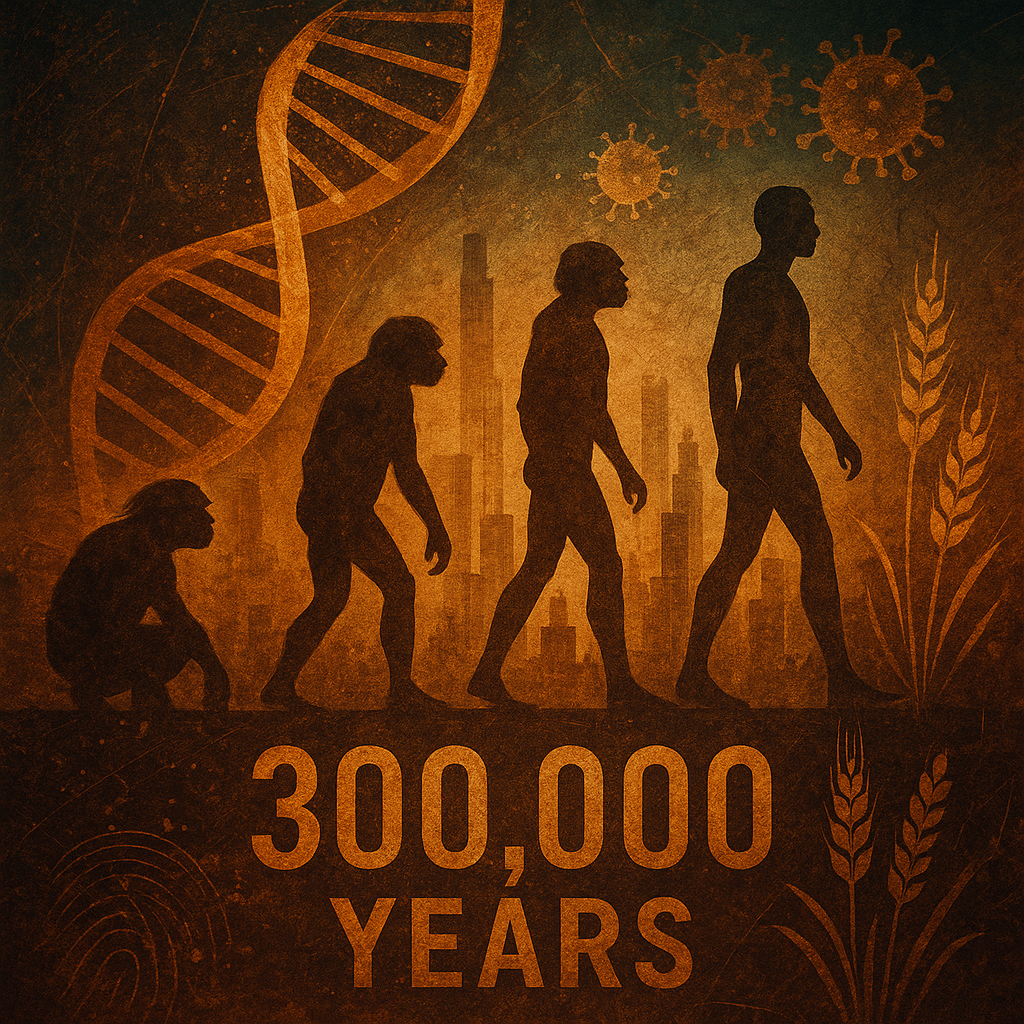
ChatGPT:
⸻
🧬 A 300,000-Year Evolutionary Odyssey of Homo Sapiens
This extended summary delves deeply into Professor Robin May’s lecture tracing the genetic journey of Homo sapiens from our origin in Africa to our modern health issues shaped by ancient adaptations. The lecture connects the dots between fossil records, genome sequencing, pandemics, and societal shifts such as agriculture to explore how evolutionary pressures continue to impact us today.
⸻
🌍 Origins and Early Human Evolution
Anatomically modern humans (Homo sapiens) evolved around 300,000 years ago in Africa. Like all species, humans were shaped by evolutionary forces like natural selection, genetic drift, and mutation. Traits that improved reproductive success tended to persist, while harmful ones faded. But our understanding of these forces remained speculative until recently.
The turning point came with whole genome sequencing and palaeontological discoveries. These breakthroughs allowed scientists to trace how ancestral genetic variants were selected over millennia, and surprisingly, how they still influence modern health.
⸻
🧬 Neanderthal and Denisovan DNA: Our Interbreeding Past
In the last decade, genome sequencing revealed Homo sapiens interbred with Neanderthals and a mysterious lineage called Denisovans. This process, called introgression, introduced foreign genes into the modern human gene pool.
• 2% of modern Eurasian genomes consist of Neanderthal DNA.
• Some Neanderthal genes conferred survival advantages, such as better immune responses.
• Others were detrimental and gradually disappeared from the gene pool.
This randomness of inheritance is not completely random—it reflects evolutionary forces that favor certain traits and purge others.
⸻
🗣️ FoxP2 Gene and Language Evolution
A striking example of negative selection is the FoxP2 gene, crucial for language acquisition and vocalization.
• Found on chromosome 7, this gene shows a complete absence of Neanderthal versions in modern humans.
• This suggests that Neanderthal variants likely impaired communication, which posed a major reproductive disadvantage.
Language is central to survival in human societies—those lacking effective communication were less likely to thrive or reproduce.
⸻
🦠 Neanderthal Genes and Viral Immunity
Conversely, positive selection preserved certain Neanderthal genes:
• On chromosome 12, Neanderthal variants of the OAS1, OAS2, and OAS3 genes help trigger stronger immune responses.
• These versions offered protection against West Nile virus, Hepatitis C, and, notably, Covid-19.
• People with these versions of OAS3 had a lower risk of severe Covid symptoms, showing how ancient adaptations continue to benefit us.
This remarkable insight links prehistoric gene flow directly to 21st-century public health outcomes.
⸻
🌾 The Agricultural Revolution and Its Costs
Roughly 10,000–12,000 years ago, human societies shifted from nomadic hunter-gatherers to settled agriculturalists. Agriculture independently arose in:
• The Fertile Crescent (Iraq, Israel, Turkey)
• Parts of Asia and the Americas
This transition had massive consequences:
• Reduced dietary diversity led to micronutrient deficiencies.
• Domesticated livestock introduced new zoonotic diseases.
• Villages and cities encouraged pathogen spread.
These challenges triggered new selective pressures on the human genome.
⸻
🍄 OCTN1 and Ergothioneine Uptake
One genetic adaptation to this new lifestyle is the OCTN1 gene, which assists in absorbing ergothioneine, a rare but essential nutrient:
• Ergothioneine is found only in certain fungi and microbes—not made by humans.
• The agricultural diet lacked it, so individuals with a variant that increased OCTN1 expression absorbed more and survived better.
• As a result, this variant became common in modern populations.
This is a textbook example of how a nutritional bottleneck drove genetic evolution.
⸻
☠️ The Black Death and Immune Evolution
Some evolutionary changes occurred over much shorter timelines. The bubonic plague, caused by Yersinia pestis, left catastrophic imprints on human genetics:
• The Plague of Justinian (541 CE) killed ~25% of Mediterranean populations.
• The Black Death (1348–1350) killed 30–60% of Europeans.
Such dramatic mortality exerted extreme selection pressure:
• Survivors often had gene variants that enhanced immune activity.
• Gene families like TLR, MHC, and ERAP surged in frequency.
• However, hyperactive immune systems today correlate with autoimmune diseases like rheumatoid arthritis.
This is a clear case of evolutionary trade-offs: past benefits come at modern costs.
⸻
🧠 The Genetic Lottery: Winners and Losers
Our genomes show a patchwork of “winning” and “losing” genes from Neanderthal and Denisovan introgression:
• “Genomic deserts” lack archaic DNA—often because those regions conferred disadvantages.
• “Genomic enrichments” show retained segments with proven adaptive value.
Thus, evolution isn’t just about survival, but the fitness and reproductive success of specific traits in specific environments.
⸻
🧪 Modern Health: A Legacy of Ancient Evolution
The most compelling message from the lecture is that many contemporary health issues are echoes of ancient adaptations:
• Immune system traits shaped by plagues now fuel autoimmunity.
• Nutritional strategies evolved for early farming are now mismatched with modern diets.
• Some genes from extinct relatives protect us today; others would have hindered us.
Understanding this helps frame modern medicine within a long evolutionary continuum.
⸻
🔚 Final Thoughts
Robin May’s lecture reframes how we view genetics, pandemics, agriculture, and human health. It reveals how deep-time biological events ripple forward, influencing everything from disease susceptibility to dietary needs. Our evolutionary story is ongoing, written into our DNA, with new chapters unfolding as environments, pathogens, and lifestyles change.
